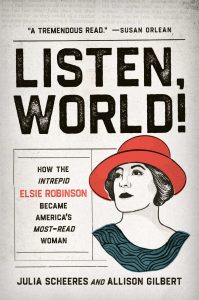Talking About Women’s History: Three Questions and an Answer with Julia Scheeres
Julia Scheeres is the co-author with Allison Gilbert of Listen World! How the Intrepid Elsie Robinson Became America’s Most Read Woman.
Scheeres grew up in Indiana as one of six siblings that included two adopted Black brothers. .
After graduating with a B.A. in Spanish from Calvin College, she moved to Valencia, Spain, for four years, where she worked as a translator and an English teacher. Next she moved to Los Angeles, where she attended U.S.C., received an M.A. in Print Journalism, and worked for the Los Angeles Times. She also worked as a reporter for United Press International, El Financiero de Mexico, and Wired News. She quit daily journalism to write her first book, but has continued publishing in many outlets, including the New York Times, O Magazine, Elle, Narrative, Pacific Standard, Newsweek, The Guardian and more.
Her first book, a memoir, titled Jesus Land, led to the closure of the abusive reform school that she and her brother David attended as teens — which she profiled in the book. Her second book, A Thousand Lives, converted her into a Jonestown scholar. She has discussed the tragedy in dozens of documentaries, articles and podcasts. Her third book, Listen World!, is radical departure: a rollicking and inspirational biography of syndicated Hearst newspaper columnist Elsie Robinson.
In addition to writing, she teaches narrative nonfiction and memoir through Stanford Continuing Studies, works privately with clients on manuscripts, and generates content for corporate clients. She is also the founder, with her two teenage daughters, of Sustainabar, a business that makes zero-waste bars of household cleaning and beauty products.
Take it away, Julia!
We’re all familiar with the challenges of finding sources for writing about women from the distant past. What are the challenges of writing about women from the early and middle twentieth century?
In Elsie’s case, the lack of a personal archive – she didn’t leave her papers to an institution. Nobody was still alive who worked with her, so we couldn’t interview them for their perspective. So we had to dig through lawsuits and read between the lines of her memoir and columns to see what was happening in her interior life. She had her outward persona — which was one of swagger and bravery — but we were able to recount a more personal, private story by triangulating information, so to speak.
What inspired you to write about Elsie Robinson? How did you come across her story?
My coauthor, a former CNN producer contacted me to help her write it. She brought the research chops, I brought the writing skills. Once I started learning about Elsie’s life, I fell in love and wanted to tell her story.
My coauthor reached out to me to help her write this book at a perfect time. My first two books are rather sad. One is a memoir that ends in tragedy and the second is a narrative history of the Jonestown mass murder-suicides. I couldn’t stand working on another sad subject after my brother died of colon cancer in his mid 50s. Elsie’s story was so inspiring. The obstacles in her way as a woman at the turn of the 20th century were profound. She wrote a lot about grief. I found great wisdom in her words and great inspiration in her personal story.
What do you find most challenging or most exciting about researching historical women?
It was fun to research the condition of women in the late 1880s – 1956, when Elsie died. The bizarre Victorian courting rituals, the dearth of knowledge about female anatomy. (Girls worried they’d get pregnant if they held hands with a boy, for example). We learned about many female heroes along the way, including Ida Craddock, who was prosecuted and jailed for writing tracts about women’s sexual response in the 1910’s — for example, how men could please, and not rape, their wives on their wedding night. About Alice B. Stockham, the fifth American woman to get an M.D., who wrote Tokology: A Book for Every Woman which offered women much-needed practical advice about pregnancy and childbirth. About Clelia Moser, a Stanford physician who conducted a groundbreaking survey in the late 1890s confirming that women enjoyed sex just as much as men.
Question from Julia: How do you define women’s history?
At its most basic, women’s history is the act of putting women back into the historical narrative, whether that means shining a light on the story of individual women or looking at the lives and accomplishments of groups of women. Because we were there, y’all. We were there.
***
Want to know more about Julia Scheeres and her work?
Check out her website: https://www.juliascheeres.com/
Follow her on Twitter: https://twitter.com/JuliaScheeres
Follow her on Instagram: https://www.instagram.com/jkscheeres/
Read an excerpt from Listen, World!: https://msmagazine.com/2023/03/16/elsie-robinson/
***
Come back tomorrow for three answers (or six, depending how you count) and a question with Olivia Meikle and Katie Nelson, two of my favorite women’s history co-conspirators






